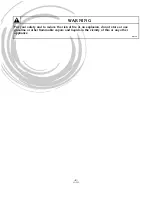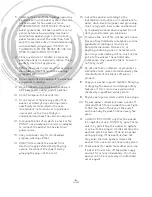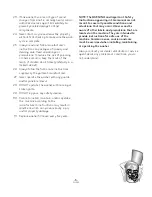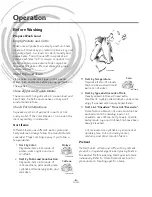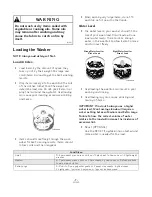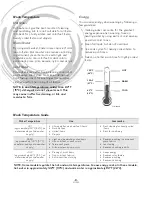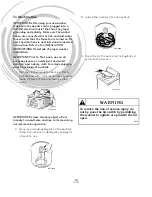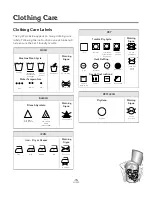
-4-
201959
5. Under certain conditions, hydrogen gas may
be produced in a hot water system that has
not been used for two weeks or more.
HYDROGEN GAS IS EXPLOSIVE. If the hot
water system has not been used for such a
period, before using a washing machine or
combination washer-dryer, turn on all hot
water faucets and let the water flow from
each for several minutes. This will release any
accumulated hydrogen gas. THE GAS IS
FLAMMABLE. DO NOT SMOKE OR USE AN
OPEN FLAME DURING THIS TIME.
6. Close supervision of children is necessary
when the washer is used near children. This is
a safety rule for all appliances.
7. Before the washer is removed from service or
discarded, remove the lid to the washing
compartment.
8. Do not reach into the washer if the washtub
or agitator is moving.
9. Do not install or store the washer where it
will be exposed to water and/or weather.
10. Do not tamper with the controls.
11. Do not repair or replace any part of the
washer, or attempt any servicing unless
specifically recommended in the user-
maintenance instructions or in published
user-repair instructions that you
understand and have the skills to carry out.
12. To reduce the risk of an electric shock or fire,
DO NOT use an extension cord or an adapter
to connect the washer to the electrical
power source.
13. Use your washer only for its intended
purpose, washing clothes.
14. ALWAYS disconnect the washer from
electrical supply before attempting any
service. Disconnect the power cord by
grasping the plug, not the cord.
15. Install the washer according to the
Installation Instructions. All connections for
water, drain, electrical power and grounding
must comply with local codes and be made
by licensed personnel when required. Do not
do it yourself unless you know how!
16. To reduce the risk of fire, clothes which have
traces of any flammable substances such as
vegetable oil, cooking oil, machine oil,
flammable chemicals, thinner, etc. or
anything containing wax or chemicals such
as in mops and cleaning cloths, must not be
put into the washer. These flammable
substances may cause the fabric to catch
on fire by itself.
17. Do not use fabric softeners or products to
eliminate static unless recommended by the
manufacturer of the fabric softener or
product.
18. Keep your washer in good condition. Bumping
or dropping the washer can damage safety
features. If this occurs, have your washer
checked by a qualified service person.
19. Replace worn power cords and/or loose plugs.
20. Be sure water connections have a shut-off
valve and that fill hose connections are tight.
CLOSE the shut-off valves at the end of
each wash day. Replace fill hoses every five
years.
21. Lid MUST BE CLOSED any time the washer
is to agitate or spin. DO NOT by-pass the lid
switch by permitting the washer to agitate
or spin with the lid open. A brake will stop the
washtub within seconds if the lid is opened
during spinning. If the washtub does not
stop when the lid is opened, remove the
washer from use and call the service person.
22. Check washer for water leaks after each use.
If water is found, turn off the water supply
and call for service immediately . Don’t use
washer until it is repaired by an authorized
service agent.
Summary of Contents for LWS02N Series
Page 28: ......


